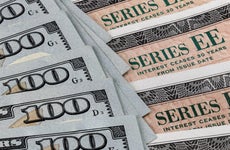4 key factors that determine CD rates

The Bankrate promise
At Bankrate we strive to help you make smarter financial decisions. While we adhere to strict , this post may contain references to products from our partners. Here's an explanation for .
When you open a certificate of deposit (CD), you agree to lock up your funds for the duration of the CD’s term — in exchange for a guaranteed rate of return that’s often higher than that of a traditional savings account.
Various factors drive CD rates up or down, and understanding what affects CD rates can help you decide if and when to purchase a CD.
Here we’ll be looking at the things that can trigger fluctuations in CD rates, as well as listing ways to find the best CD rates and how to decide if a CD is right for you.
1. Changes to the Fed’s benchmark rate
Twelve members of the United States Federal Reserve meet eight times a year to assess the country’s economic state (including the rate of inflation) and make resulting monetary policy decisions. One action they may choose to take is raising the Fed’s benchmark rate, which is called the Federal funds rate.
When the Federal funds rate goes up, banks tend to follow suit by raising the interest rates on loans they make. Likewise, when the Fed’s benchmark rate is decreased, banks lower the cost of borrowing.
Yields on deposit accounts generally work the same way (at competitive banks), by increasing and decreasing in tandem with the Federal Funds rate. The Fed raised that rate seven times in 2022 and three times so far in 2023 — and along with that rate’s steady increase, annual percentage yields (APYs) have risen on many CDs, savings accounts and money market accounts.
The national average one-year CD rate, for instance, has overall been increasing steadily since the Fed started raising interest rates in March 2022.
2. Competition among banks
When a bank finds itself in need of more cash, it may decide to increase the APYs on its savings accounts and CDs in hopes of attracting more customers. This is a strategy sometimes employed by newer banks and online banks, who want to build up their customer base and draw depositors from big banks (many of which are already flush with cash).
For instance, these days it’s easy enough to find a one-year CD that pays 5 percent or higher at banks that operate exclusively online. Banks that offer such rates include Bask Bank and CIBC Bank USA.
By way of comparison, one-year CDs at megabanks Chase and Bank of America currently earn 0.01 and 0.03 percent, respectively. Such rock-bottom APYs are hundreds of times lower than the highly competitive ones.
3. Changes in Treasury yields
The Treasury yield is the interest rate the U.S. government pays on its debts. Banks use the funds they get from deposits — including CDs, which are time-deposit accounts — for the loans they give out as well as their investments in Treasurys. Rising Treasury yields may trigger banks to increase their CD yields, in turn.
4. CD term length
While some savers prefer shorter-term CDs for their flexibility, you may get higher rates from longer-term CDs. Historically, banks have often paid better yields to customers who were willing to lock up their money for longer periods of time.
However, in today’s economic environment, many banks are paying higher APYs on one-year CDs than on five-year CDs, for instance. This type of inverted yield curve can also happen with Treasury yields, and it generally means economists predict a recession is on the way.
As such, these days it’s important for anyone in the market for a CD not to assume longer terms will automatically earn higher APYs than shorter ones.
How to find the best CD rates
Shop around: Bankrate provides comparisons of the current best CD rates for a variety of term lengths.
See which banks pay the best rates: Generally, you’ll find the highest rates among online banks and some credit unions, although it’s not unheard of to find a competitive yield from a big bank.
Pay attention to minimum deposit requirements: In addition to the APY, pay attention to minimum deposit amounts. Some banks don’t require any set minimum deposit while others may require up to $10,000, so make sure any bank you’re interested in doesn’t require more money than you’re planning to put into the account.
How to decide if a CD is right for you
Consider locking away your funds: CDs usually have early withdrawal penalties, so be sure you’re comfortable with tying up your money for the duration of a CD’s term. If there’s a chance you’ll need the funds for living purposes or unplanned expenses in the meantime, you’re better off keeping your money in a liquid savings account.
Look for better yields elsewhere: When shopping around, you might find a high-yield savings account that pays a better yield than you’re finding among CDs. If this is the case, it’s not worth locking up your funds in a CD right now.
Pay attention to the current rate environment: In a rising rate environment, you could lose out by tying up your money in a CD if rates are likely to rise even more in the coming months. Likewise, savers may benefit from going with a fixed-rate CD at a time when rates are progressively falling.
Related Articles



